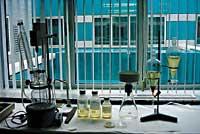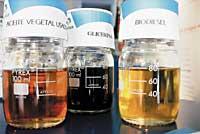More and more biodiesel

The Gaiker technology centre is developing the project to obtain biofuels. For this purpose it has the collaboration of the Institute of Catalysis and Petrochemistry of the CSIC, the School of Industrial Engineers of Bilbao and the University of Malaga. The project allows, among other things, to recycle the oil used to fry every day. Of course, it cannot be said that everyone can become biodiesel, but some can.
The project began in 2003 and will last three years. The final objective is to obtain a biodiesel to be used as fuel in cars complying with the current legislation.
Where is innovation?
The production of biodiesel is not a novelty. In fact, in Euskal Herria there are already companies that manufacture this fuel. And not only that, but Gaiker himself has already worked on the production of this fuel. The latest novelty lies in the biodiesel production method.
It can be done by a homogeneous catalysis. Or so far it has been done. In the case of the homogeneous catalyst the consumption of the catalyst is carried out along the reaction and its elimination requires a cleaning process. To avoid this, this new project aims to use a heterogeneous catalysis, due, among other things, to the elimination and recovery of the catalyst through a separation process. Therefore, from the economic point of view, the cost of the process decreases.

On the other hand, if we focus on the environmental aspect, the method used so far for biodiesel production, in the cleaning process in general three stages were differentiated. On the one hand, the stage of neutralization, a stage in which a base and an acid react. On the other hand, to remove the products that were produced in this stage of neutralization, in general a salt was added. And finally, cleaning with water to remove final residues or impurities. This new method, however, will have a single cleaning stage. Moreover, the use of chemical substances is probably not necessary. Therefore, chemical substances and discharges will be much lower and their degree of contamination.
Simple and economical process
The biodiesel production process can be considered simple and economical. The first job is to collect the raw material, that is, the oil. Once the oil is collected, the first task is to remove solids and excess water. Subsequently, the oil is transformed into glycerin and methyl ester, that is, for the production of biodiesel. For an adequate reaction to occur, it is important to accurately measure the proportion of each component. It is, in short, a transesterification, a vulgar word. But it is simply adding a reagent, in this case adding alcohol to the oil. Thanks to the catalyst, the reaction occurs quickly and finally two phases are obtained: an organic, a mixture of methyl esters, biodiesel, and another aqueous phase, glycerol.
These phases are separated and the biodiesel is clean and dry. And once proven to meet all the requirements, it is mixed with conventional diesel and takes the fuel to the gas station to make it available to the customer. Despite the disadvantages of biodiesel, there is no doubt that it is a step further towards a cleaner fuel. But its advantages are not those that should have a final fuel. However, taking the necessary precautions and measures and contaminating less than diesel, it can be fuel for the coming years.
www.ihobe.net
Biodiesel...
...advantages. Biodiesel has many advantages, not only environmental, but also energy and economic. It offers new business opportunities to the rural environment, for example. In fact, to obtain biodiesel can be used raw materials such as fat seeds (sun, soy, coconut..), fatty fruits (palm), high acidity olive oils, animal fats, etc.
On the other hand, biodiesel emits less polluting gases than conventional diesel. It is a fuel equivalent to diesel, but biodegradable and with lower polluting emissions. In fact, biodiesel does not contain almost sulfur or chlorine, and emits less particles by the exhaust. For example, no oxides of sulfur are emitted by the exhaust of the car. The emission of carbon dioxide is equal to zero, since the plants of the fat seeds consume the same amount of CO 2 as the biodiesel in their growth cycle.

Pure biodiesel has low toxicity in water and being biodegradable completely disappears in 30 days. These features make it a safer fuel for accidents.
From a technological point of view, biodiesel is fully compatible with Diesel engines. The use of biodiesel requires no change in the engines, improving their duration and performance.
...disadvantages. If the process of obtaining biodiesel is strictly observed, it is observed that glycerin that forms as a side product can cause problems. Although this material is used for other industrial processes such as the manufacture of soaps, overproduction would generate surplus. These glycerin surplus may become a problem for nature, as it happens with the rest of the surplus, due to the lack of discharge. In addition, the elimination routes of these surplus would increase the cost of biodiesel.
Another feature of biodiesel also has a small disadvantage. The biodiesel is more viscous, so at low temperature it is not manageable. Therefore, it may not be available in cold areas. In fact, biodiesel is frozen 2-3 times faster than fuels derived from oil. It is not a difference, but it can influence.
Buletina
Bidali zure helbide elektronikoa eta jaso asteroko buletina zure sarrera-ontzian











